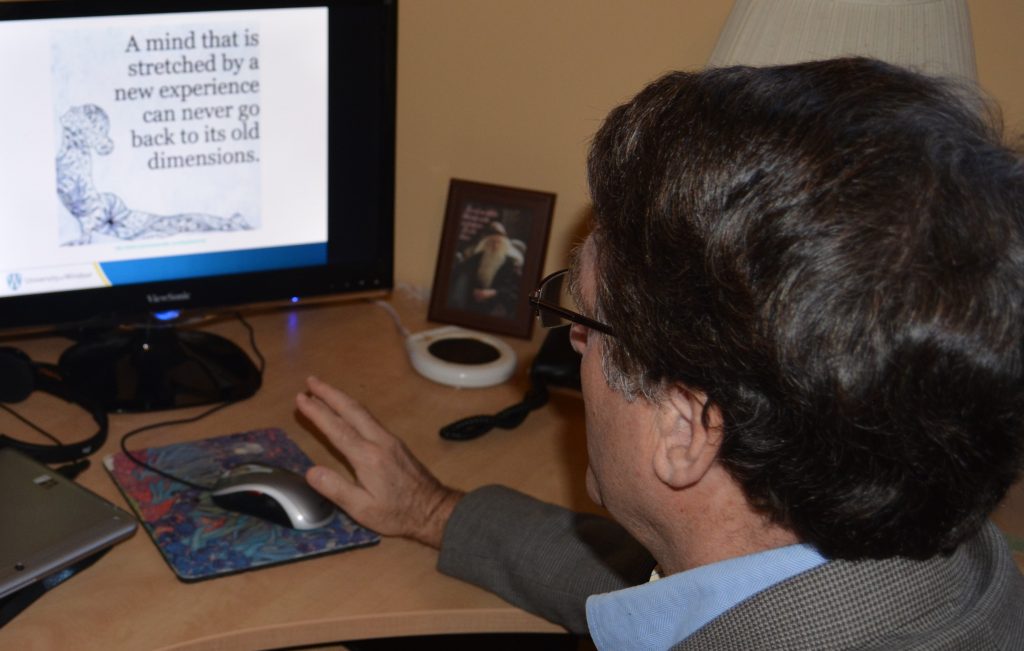Home » Posts tagged 'Open Education Resources'
Tag Archives: Open Education Resources
Scary and Fascinating: Online Teaching in Challenging Times
Have you ever started writing on a topic and then something happens that changes everything? Well, that just happened to me. About a month prior to the COVID-19 pandemic, I was writing on the growing interest in and support for open and online learning in postsecondary education. Then poof! COVID-19 changed everything. Today I will share with you some of my initial thoughts on this topic and then reflect on how the events of the last month changed some of my thinking.
Here are some of my initial thoughts.

Following completion of the University of Windsor Office of Open Learning’s Certificate of Online and Open Learning and attendance at eCampusOntario’s Technology + Education Seminar + Showcase (TESS) conference, I initiated a study to explore the connection between the promising practices for teaching online linguistically and culturally diverse international students and student satisfaction and student perceptions of learning, which has recently received research ethics approval but is now paused. An overview of this study is available on my faculty web page. Also, working with two University of Windsor colleagues (Mark Lubrick and Carson Babich), I oversaw the writing of my first Open Educational Resource textbook (Leadership and Management in Learning Organizations), which we hope to publish in the next few months. All of this opened my eyes to the possibilities of online learning within the higher education sector.
And then, just before the pandemic broke, I enjoyed reading the Wiley Education Services study, “Student Perspectives of Online Programs: A Survey of Learners Supported by Wiley Education Services” (Magda & Smalec, 2020), in which student satisfaction with online learning was explored at 19 institutions where students were enrolled in Wiley-supported programs. The study provided some fascinating insights that showed ways to better meet student needs and expectations, including examine the complete student journey to remove barriers to flexibility, create a consistent learning experience to alleviate unneeded stress, and empower faculty to engage with students to improve the learning experience.
And here is a little of what we knew about online learning in North America before COVID-19.

North American online education has seen a rise in popularity in recent years. The Canadian Digital Learning Research Association reported that Canadian postsecondary online course registrations grew by 10 percent in 2018 and 2019, and most institutions expect enrollments to increase in the coming year (Johnson, 2019). The U.S.-based National Center for Education Statistics (Ginder, Kelly-Reid, & Mann, 2017) reported that the number of students who take at least some of their courses online grew by 5.7 percent in 2017. More than 25 percent of students take at least one online course during their time at university of college (Cook, 2018). Undergraduate international students attending Canadian institutions are increasingly choosing to take online courses (Best Colleges, 2019; Thomson, & Esses, 2016).
And here is some of my thinking since COVID-19 joined our world.
Like most faculty, I found myself scrambling a bit to convert my in-person courses, some of which were hybrid courses, to fully online courses. With lots of support from our Office of Open Learning and Centre for Teaching and Learning, as well as experienced colleagues, I made the leap. It was a bit scary, but also fascinating.
On the scary side, there is me. While I had recently acquired professional development in open and online learning, I am an in-person educator who greatly enjoys the interaction with students. Seeing their smiles and their fears is a big part of how I ensure a learning-centred classroom environment. When this all moved to being digital, I, like many of my colleagues, was petrified. Then there are my students, who were equally scared since all of this happened within the last three weeks of the semester. Fortunately, our university put in place a flexible approach that included assessments and grades, which allayed many of their fears. But not all.
When I had my students online, I asked them about their experience. Here is what an international graduate student said:
While we miss the in-person connections with other students and our professors, going online was not really a problem. When I delivered a facilitated reading discussion, I found that I had more confidence due to my comfort with digital technology. I also found that there was more participation in class. Although in-person instruction is my preference, I found aspects of my online classes to be better than expected. In some cases, preferable to my in-person experience!
I also found the whole process fascinating. What we know is that our classes are filled with digital natives; that is, students who have always had technology in their lives. Taking ourselves, who might be described as digital immigrants, out of our comfort zone and letting students be our guides through this new digital world I found exciting and a little fun. It provided a flipped classroom of sorts where the students were doing some of the teaching, and we became the students. What could be more exciting?
Like many other postsecondary institutions, my university is offering its summer courses fully-online. There is also the likely possibility that fall classes similarly will be fully-online. Finishing off a term with online lectures is one thing. Moving to all courses, from beginning to end, being online is something all together different. The good news is we will all be doing it together.
Scary but fascinating!
-Clayton Smith
Best Colleges (2019). 2019 Online Education Trends Report. https://res.cloudinary.com/highereducation/image/upload/v1556050834/BestColleges.com/edutrends/2019-Online-Trends-in-Education-Report-BestColleges.pdf
Cook, J. (2018). Online education and the emotional experience of the teacher. New Directions for Teaching and Emotion. DOI: 10.1002/tl.20282
Ginder, S. A., Kelly-Reid, J. E., & Mann, F. B. (2017). Enrollment and employees in postsecondary institutions, fall 2016; and financial statistics and academic libraries, fiscal year 2016. Washington, DC: National Center for Education Statistics. https://nces.ed.gov/pubs2018/2018002.pdf
Johnson, N. (2019). Tracking online education in Canadian universities and colleges: National survey of online and digital learning 2019 national report. https://onlinelearningsurveycanada.ca/publications-2019/
Magda, S. J., & Smalec, J.S. (2020). Student perspectives on online programs: A survey of learners supported by Wiley Education Services. Louisville, KY: Wiley edu, LLC. https://edservices.wiley.com/student-perspectives-on-online-programs/
Thomson, C., & Esses, V. (2016). Helping the transition: mentorship to support international students in Canada. Journal of International Students, 6(4), 873-886. http://ojed.org/index.php/jis/article/view/323/247
Connecting Today’s Postsecondary Classroom to the Open Future
Postsecondary presidents and administrators are concerned about the rising cost of textbooks, with 85% of leaders supporting the use of OER’s (Lederman, 2019, March 13). Many education faculty members are increasingly looking to make use of OERs to customize their teaching resources to ensure that they are a good fit for the courses they are teaching. This is especially true for instructors engaged in teaching interdisciplinary courses in educational administration, policy, and leadership where there is no currently available open or online textbook.
At this year’s Canadian Society for the Study of Higher Education Conference, which will be held May 31-June 2, 2020 at Western University in London, Ontario, I will be joined by two of my University of Windsor colleagues (Mark Lubrick and Carson Babich) as cochairs for the panel, “Connecting Today’s Postsecondary Classroom to the Open Future: Open Education Resources (OER’s) Empower the Teaching of Educational Administration, Policy, and Leadership,” which will focus on the use of OER’s to teach interdisciplinary courses through the exploration of new pedagogical approaches.

This panel will focus on two main research questions. How are postsecondary faculty making use of OER’s to teach interdisciplinary courses in educational administration, policy, and leadership with a particular focus on learning organizations? What specific factors should be considered when using OER’s to teach interdisciplinary courses?
Consider submitting a proposal. Some possible topics that you may want to consider could include: accessibility, class discussions, connection from one discipline to another, epistemology, equity, ethics evaluating/choosing a resource, experiential learning, flipped teaching, online collaborative teaching (OCT), pedagogical innovation, and research done around OER use in interdisciplinary courses
For more information contact me at Clayton.Smith@uwindsor.ca.
-Clayton Smith
Recent Comments